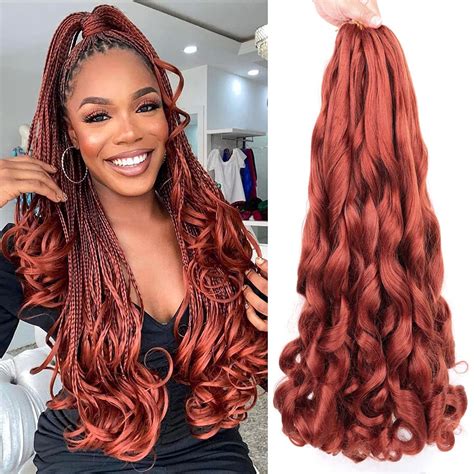Introduction
Braiding hair extensions have become increasingly popular among women of all ages, ethnicities, and hair types. They offer a versatile and transformative way to add length, volume, color, and style to natural hair. This comprehensive article explores the world of braiding hair extensions, providing insights into different techniques, benefits, and tips for achieving a flawless look.

Benefits of Braiding Hair Extensions
Braiding hair extensions come with a plethora of advantages, including:
-
Length and Volume: Extensions instantly add extra length and volume to thin or short hair, creating a fuller and more voluminous look.
-
Color Enhancement: Extensions allow for vibrant color experimentation without damaging natural hair. They can be used to add highlights, lowlights, or even create an ombré effect.
-
Styling Versatility: Braids can be styled in countless ways, from intricate updos to elegant ponytails, allowing for endless styling possibilities.
-
Protective Style: Braids can act as a protective style for damaged or fragile hair, shielding it from environmental damage and reducing breakage.
Types of Braiding Hair Extensions
There are numerous types of braiding hair extensions available, each with its unique characteristics:
-
Kanekalon: A synthetic fiber that is heat-resistant and easy to braid. It offers a natural-looking finish but can be prone to tangling.
-
Human Hair: Natural human hair extensions provide a seamless blend with natural hair, but they are more expensive and require careful maintenance.
-
Yarn: Colorful and textured yarn can be used to create playful and eye-catching braids.
Braiding Techniques for Hair Extensions
The choice of braiding technique depends on the desired look and hair texture. Some common techniques include:
-
Box Braids: Rectangular sections of hair are tightly braided to create a bold and geometric look.
-
Cornrows: Tightly woven braids that follow the natural hair pattern, providing a sleek and elegant style.
-
French Braids: Sections of hair are interwoven to create an intricate and sophisticated design.
-
Senegalese Twists: Two-strand twists that are intertwined to form rope-like braids, adding texture and volume.
Tips for Successful Braiding Hair Extensions
Achieving a flawless look with braiding hair extensions requires careful preparation and technique. Here are some tips to help:
-
Match Hair Color and Texture: Choose extensions that closely match your natural hair color and texture for a seamless blend.
-
Prepare Hair Properly: Wash and detangle natural hair before braiding to ensure a clean and smooth base.
-
Use Quality Extensions: Invest in high-quality extensions that are durable and resistant to matting.
-
Take Breaks: Braiding can be time-consuming, so take breaks to rest your hands and avoid tension.
-
Moisturize Regularly: Keep braids moisturized with hair oils or leave-in conditioners to prevent dryness and breakage.
Comparison: Pros and Cons of Braiding Hair Extensions
Like any hair enhancement method, braiding hair extensions have both advantages and disadvantages to consider:
| Pros | Cons |
|---|---|
| Length and volume enhancement | Time-consuming installation |
| Styling versatility | Potential for tangling |
| Protective style | Can be uncomfortable to sleep with |
| Color customization | Regular maintenance required |
Effective Strategies for Maintaining Braided Hair Extensions
Proper care and maintenance are essential for the longevity and health of braiding hair extensions:
-
Wash Regularly: Wash braids gently with sulfate-free shampoo every 2-3 weeks, avoiding the use of harsh products.
-
Detangle Regularly: Use a wide-toothed comb or your fingers to gently detangle braids daily, starting from the ends and working towards the roots.
-
Dry Thoroughly: Allow braids to air dry completely to prevent moisture buildup and mold growth.
-
Moisturize: Apply hair oils or leave-in conditioners to keep braids hydrated and prevent breakage.
Frequently Asked Questions
Q: How long do braiding hair extensions last?
A: The longevity of braiding hair extensions depends on the type of extension, maintenance routine, and natural hair growth. With proper care, they can last anywhere from 4 to 12 weeks.
Q: Can you swim with braiding hair extensions?
A: It is not recommended to swim with braiding hair extensions, as chlorine and saltwater can damage and loosen the braids.
Q: Are braiding hair extensions damaging to natural hair?
A: When installed and maintained properly, braiding hair extensions are generally not damaging to natural hair. However, tight braiding or excessive tension can cause breakage or hair loss.
Conclusion
Braiding hair extensions offer a transformative and versatile way to enhance natural beauty. With various techniques, colors, and textures available, women can achieve their desired look while protecting and styling their hair. By following the tips and strategies outlined in this article, you can confidently embrace the art of braiding hair extensions and flaunt a captivating new hairstyle.
